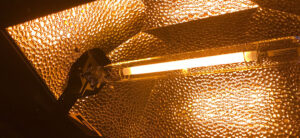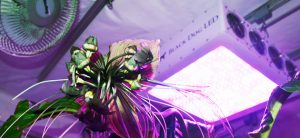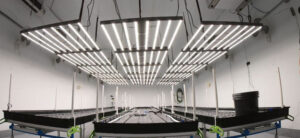
Whether you’re just starting with your indoor grow or looking to upgrade your current setup, knowing the difference between single-ended and double-ended grow lights is essential.
Ask any grower, and you’ll likely get a different answer about which is better.
This is because it depends on how you grow. We’ll cover everything you need to know about SE and DE grow lights, and help you pick the right one for your grow light setup.
What is the Difference Between Single Ended and Double Ended Grow Lights?

Single-ended grow lights are the most antiquated form of MH and HPS systems.
They are based on the same technology as the first gas-powered lamps.
What “single-ended” means is that the bulb screws in and attaches on just one side, similar to a traditional light bulb.
Single-ended grow lights are easy to install, making them a good choice for beginners.
That’s why these are the most popular types of lights for hobby growers.
A double-ended grow light, on the other hand, is a higher-powered bulb, usually found in wattages between 600 and 1000 watts.
The main difference between these bulbs is just their construction and output.
SE lights spin into sockets and are only powered on one end, while DE lights contain two wires on both sides of the bulb that then fasten back into the reflector’s sockets.
Because the internal arc tube is shorter and more narrow, it offers more intense light, making these better for more serious growers with bigger grows.
While HIDs, in general, have a reputation of being outdated with the resurgence of LEDs and CMH lights, DE grow lights have been constantly improved upon to remain relevant.
These changes improve light quality and output. One of these is the elimination of the wireframe that holds an arc tube in place in a typical single-ended grow light.
Though necessary for a single-ended grow light to function, this wireframe degrades the quality of light. Let’s take a deeper look at each one of these technologies.
Benefits of Single Ended Grow Lights
A single-ended grow light is the best choice for a hobby grower. If you’re a first time grower or only want to grow a few plants here and there, a single-ended light is perfect. Installation is simple, and so is operation.
Single-ended lights operate at cool temperatures, too, so managing grow room heat will be way easier. Furthermore, you can place the light closer to the canopy compared to a DE light, which must be mounted several feet above the plants.
Therefore, single-ended grow lights are the obvious choice when it comes to choosing a light for a small, low-budget grow room.
Benefits of Double Ended Grow Lights
Double-ended grow lights are, without a doubt, the go-to solution for commercial growers.
The light emitted is more powerful and distributed more evenly.
DE lights produce up to 30% more intense light than their SE counterparts, but the spectrum is more ideal as well.
They produce more infrared and ultraviolet light.
UV and infrared light are important because they increase terpenes along with potency.
DE lights get you a type of light closer to the sun, and they tend to be more efficient. They use less energy so your electric bills will be lower.
Not only that, they tend to last longer, saving you money on replacement bulbs.
While you might pay a bit more upfront for a DE grow light, you’ll find that you get your money’s worth, as they last several thousand hours of growing and maintain their output until they burn out.
How to Tell the Difference Between Single Ended vs. Double Ended Grow Lights
If you’re not sure what kind of grow light you’re looking at, there’s an easy way to tell the difference. Look at the bulbs.
A double-ended grow light will be skinny and it won’t screw into a socket. The bulb might be smaller, as it doesn’t have to house an arc tube and its elements.
A single-ended bulb, on the other hand, will have a long, metal frame that travels from the base to the very end of the bulb.
The frame holds the arc tube and contains the material necessary for light. To sum things up, double-ended grow lights (versus single-ended lights):
- Have two connection points, one at either end, while single-ended grow lights only have one
- Produce a greater light output, but more heat simultaneously
- Are a bit more expensive, but are a better investment due to longevity
- Work best in commercial growing situations that require high light intensity and have the means for removing excess heat
Which Type of Grow Light is Best For My Grow Room?
While it’s easy to argue that double-ended grow lights are going to be higher-performing and more efficient, that doesn’t necessarily make them the best choice for your setup.
SE grow lights work best for hobbyists, DE grow lights work best in more serious commercial applications. This is the best rule of thumb.
There is no question DE grow lights put out more light, but they can often be overkill in smaller grows.
In fact, they can be detrimental by stressing your plants and producing heat, while driving up your energy bill. If you only have four plants, for example, you really don't need a DE grow light.
So while there are advantages to using double-ended grow lights in a large or commercial setting, smaller grows are better suited with single-ended lights.
Consider your growing goals and needs before making the decision. No matter which style you opt for, we have the ultimate selection of grow lights.
If you aren't quite sure which is best for your grow, give us a call at 888-815-9753 and we'll help you decide!














